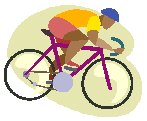The Bicycle and You
BICYCLING is a fun and healthy exercise. Before riding on to
the road, take time to learn the rules. Many bicyclists are injured seriously in
accidents because they are less protected than drivers of cars and other
vehicles. Remember, you also need to practise safe riding skills.
Some safe riding hints
-
 Wear a bike helmet at all times. The most serious bike
injuries are to the head Wear a bike helmet at all times. The most serious bike
injuries are to the head
-
Keep your bike in good shape
-
Always let cars and people go first
-
Slow down and check traffic at corners
-
Keep both hands on the handle bars, except when giving turn
signals
-
Walk your bicycle across busy streets at designated
crosswalks or pedestrian-friendly intersections
- Try to stay off busy streets as far as possible. If you have no option but to
ride your bicycle in busy areas keep as far to the left of the road as possible
or use designated bicycle lanes if they are available
Why you need a helmet
-
Bicycle helmets are an essential element to bicycle
safety
-
Always strap on an approved safety helmet before you ride
-
Helmets are an important safety device to protect your
head and brain from injury. If you donít have a helmet, ask your parents
to buy you one
Check your bicycle for defects
You should regularly check your bicycle to ensure that it is in optimal
working order.
- Chain: It should be neither too tight nor too slack. Allow three
centimetres play. Replace worn or damaged links. Each link pin and its
roller requires a drop of oil to keep the chain working smoothly
- Spokes: They must be at the correct tension and perfectly straight as
they hold the wheel rim in place and in shape. Loose spokes can be
tightened, but those damaged must be replaced
- Rims: They must not be dented or buckled if the brakes are to work
efficiently
- Saddle: It should be firmly attached and adjusted to the correct
height Ė slightly lower than the handlebars
- Oiling: Oil moving parts regularly, at least once a month if you use
it every day. Make sure that you use the correct oil
- Tyres: They should be fully inflated. Examine the treads once a
month. Smooth tyres can cause you to skid. Remove stones and any other
objects that may be stuck in the treads
- Warning bell: It must be one that works
- Lights and reflectors: The bicycle must be equipped with a lamp
emitting a bright white light. But remember, cycling at night can be
hazardous. It is best to avoid it. At the back, a red reflector should
be fitted on a mudguard painted white. In front, the bicycle must be
fitted with a white reflector. Alternatively, use luminous red and white
tape
- Brakes: Ensure that they are working well
What parents need to know
- Donít buy your children bicycles to "grow into". If the
bicycle is not the right size for your child, it is dangerous to ride it
- Supervise your children when they ride their bicycles
- Encourage them to wear their helmets at all times when riding. Make it a
rule - no helmet, no riding of their bicycle
- Discourage your child from doing stunts and other dangerous activities
when riding

Related Topic
Causes of bicycle accidents and prevention

 back back
|
 Wear a bike helmet at all times. The most serious bike
injuries are to the head
Wear a bike helmet at all times. The most serious bike
injuries are to the head

